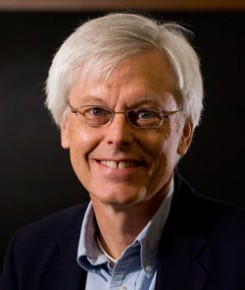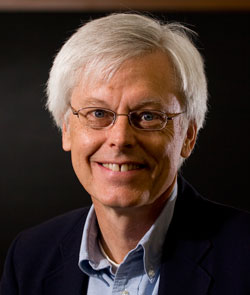Editor’s Note: This is the fifth installment in a series covering the Occupy Wall Street movement and its effects both on and off campus.
On Thursday, November 18, Connecticut College hosted a discussion by Psychology Professor Stuart Vyse called the “Failures and Pitfalls of the Occupy Wall Street Movement,” which focused mainly on the student loan crisis. The event, which took place in the Charles Chu Room, was well attended by approximately thirty students, several professors and many representatives of CC Dissent, a new group on campus that supports the Occupy Wall Street movement and advocates for its causes on campus.

Psychology Professor Stuart Vyse
Professor Vyse was a deliberate choice for hosting the talk, as he recently authored the book Going Broke: Why Americans Can’t Hold On To Their Money and teaches a course on behavioral economics. He referred to the text throughout the lecture, discussing the ways in which people relate to money and debt.
According to Professor Vyse, our current society lives with the myth of the American Dream, whereby making money is entirely dependent on hard work and personal responsibility. “Money is central to who people are,” he said. “There are a lot of attributions made about people in respect to money and there’s also personal philosophies in life regarding how we talk about it.”
However, he went on, the Occupy Wall Street movement has pointed out that making money “is not just about hard work. If it were, then there would be a lot of people up on this hill [at Connecticut College] who aren’t here now.”
Another concern that the Occupy Wall Street movement has addressed is student loan debt, something that many students on the Connecticut College campus can relate to. With a comprehensive fee of $54,970, one of the top five most expensive colleges in the country (and therefore among the world’s most expensive institutions), many students must take out loans in order to attend. Professor Vyse pointed out that what it takes to “get up onto this hill,” to attend a private, elite, liberal arts college, does require a lot of money, and many students ultimately graduate with thousands of dollars of debt.
One of the main demands of the movement, which has been supported by several economists, the New York Times columnist David Brooks, as well as Professor Vyse himself, is student debt forgiveness. “Student loan debt should be potentially expugnable in bankruptcy proceedings. You will be indentured to bankruptcy and that is the problem. This is worth being angry about,” said Professor Vyse.
When corporations go bankrupt, which essentially means that their assets are no longer sufficient to cover their debt obligations, their remaining assets are liquidated in order to repay loans and bondholders. The case typically goes to bankruptcy court. However, as Professor Vyse points out, there is no equivalent for students drowning in overwhelming debt. They become indentured servants to that debt for years.
In order to avoid this outcome, Professor Vyse advises students to avoid debt and view money differently. What our capitalist economy wants for you to do, he said, is “to earn a lot of money and spend it all,” and what is even more preferable from that standpoint is “to spend more than you earn and go into debt because that makes money for the lending class.” He even points out that in the wake of the September 11, 2011 attacks, President George W. Bush advocated for consumerism as “our American duty.”
“Think very seriously about earning a lot of money but not spending a lot,” Vyse warned. “There is great power in the money that you earn as individuals and I would urge you to make money but not spend it. There is great power in being good with money. Avoid getting into debt as much as possible.”
In the spirit of the Occupy movement, Professor Vyse cited the anti-consumerist organization Adbusters, one of the chief supporters of Occupy Wall Street, which has appropriated “Black Friday,” one of the biggest shopping days in the American year, and changed it to “National Buy Nothing Day.”
Professor Vyse is no stranger to social movements. For years, he was involved in left-wing social movements, marching against the war in Vietnam at the Pentagon in the 1970s, and more recently protesting against the Iraq War. With this historical view of recent leftist social movements, he cited one of the pitfalls of the Occupy movement, arguing that Occupy Wall Street is somewhat disorganized.
“It would be beneficial [if the movement were more organized], but what I’m suggesting is that the most important thing is to keep the positive energy moving and to not do anything crazy that will cause negative publicity. For those of us of my generation who have been involved in movements, this is the most exciting thing that has happened in a long time,” he said.
Despite its disorganization, the movement has changed the dialogue. Now, he said, “Even Republicans have to answer questions like, ‘What are you doing about economic inequality?’”
In addition to the ostensible disorganization of the movement, CC Dissent organizer Eliza Bryant ’12 pointed to other shortcomings of the movement, “which all have some piece of validity,” including lacking any particular agenda, and having no real organizational leadership.
Another organizer for CC Dissent, Ann Daly ’12, added that “many people involved in Occupy Wall Street have very good ideas but perhaps they’re not the best at describing them. I find myself very disenchanted by the level of education about the issues that the people claim to be protesting. This has led to some very harebrained ideas and talking points.”
For instance, Daly cites the fact that few in the movement are discussing the connection between the recession in this country and the European debt crisis. She added, “Most protesters probably wouldn’t be able to understand quite what’s going on.”
However many of the organizers believe that the media is responsible for creating the stereotypes of Occupiers as undereducated about the movement, as simply hippies seeking out a cause or a handout. Organizers responded to comments by a student who attended the lecture who echoed such sentiments, arguing that it seems as if “a lot of protesters who have been interviewed haven’t articulately explained their views or points and do not necessarily align with the movement. It has given this façade of hippies who don’t know what they are talking about.”’
“We don’t choose whose interviews we get to see. This is the media’s choice,” responded organizer Gautham Sinha ’13.
In an attempt to help control these media images, organizer Elizabeth Larkin ’15 said that the network CNBC actually contacted CC Dissent, in hopes that it could document an Occupy Wall Street-esque live-in at the Connecticut College campus. Ultimately, however, CC Dissent turned down the offer in order to not make a “spectacle” that could be easily manipulated by the media.
“We haven’t decided to do a campus live-in because we don’t have enough momentum or support from the student body. We don’t have any direct demands on our administration and it doesn’t make sense right now,” Larkin explained.
While it seems as though the discussion at Thursday’s lecture was somewhat insular, relegated mainly to the organizers of CC Dissent, Larkin pointed out the importance of self-critique.
“By being critical of the movement ourselves rather than allowing just the press and the opposition to be critical of us, we take some of that power back, not in order to dismiss, dismantle and vilify it, but to make it stronger.”
And how, precisely, does CC Dissent, already a fairly visible group on campus, plan to grow? The group appears to be something of an anomaly, with many Connecticut College students questioning its very name, its actions and its goals. What exactly is the group “dissenting” from?
Bryant said, “Dissent works because it just speaks to certain things that are going on in our country that we don’t agree with, that we’d like to see changed. This is a group that addressees issues that they would like to amend, and dissent is essential to democracy.”
Echoing Bryant, organizer Mihir Sharma ’12 said that dissent means “not being happy with the way things are and acting upon it.”
Larkin, like many students on campus, finds that the group isn’t “dissenting” as much as its name perhaps suggests. “We need to take more direct and local action and incorporate a broader base. So far we have gotten a really unthoughtful and unquestioned kind of rejection from SGA which was frustrating for us.”
On the group’s name, Larkin continued, “I believe it is dissent to the passivity of the status quo. I think if our actions on campus so far have not caused a rewriting to the C-book or better healthcare for the cafeteria workers, at least perhaps they have done something to draw attention to issues, and perhaps reject the passivity toward some issues.”
Regardless of the impact that CC Dissent has or has not had on the Connecticut College community, Professor Vyse urged students to “please keep hope alive” with the movement, and continue fighting. This statement is particularly compelling in the wake of increased regulation at Zuccotti Park this past week, when over 175 protesters were arrested for attempting to shut down the New York Stock Exchange. •











[…] This post was originally published by the College Voice on November 21, 2011, here. […]